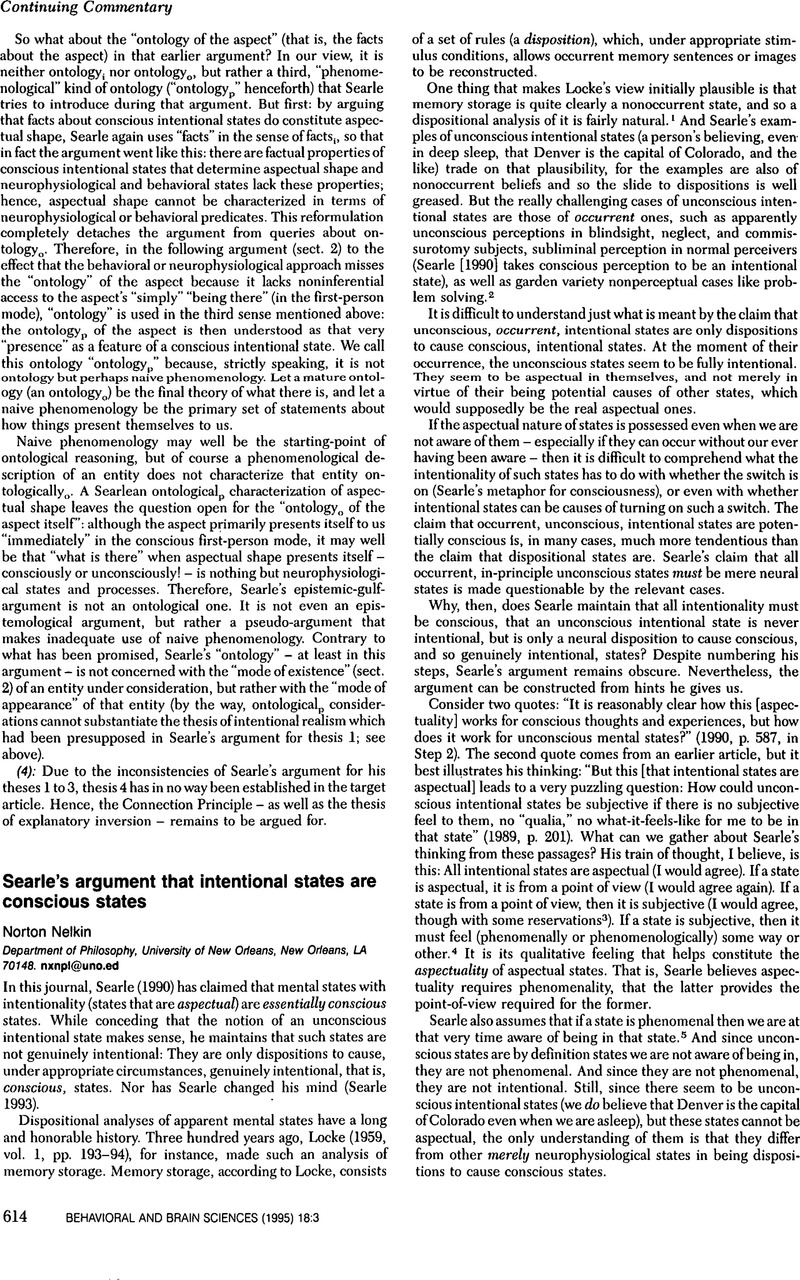No CrossRef data available.
Article contents
Searle's argument that intentional states are conscious states
Published online by Cambridge University Press: 04 February 2010
Abstract
An abstract is not available for this content so a preview has been provided. Please use the Get access link above for information on how to access this content.

- Type
- Article Commentary
- Information
- Behavioral and Brain Sciences , Volume 18 , Special Issue 3: An International Journal of Current Research and Theory with Open Peer Commentary , September 1995 , pp. 614 - 615
- Copyright
- Copyright © Cambridge University Press 1995
References
Block, N. (1990) Consciousness and accessibility. Behavioral and Brain Sciences 13(4):596–98. [JS]CrossRefGoogle Scholar
Dennett, D. (1988) Prećis of The intentional stance
. Behavioral and Brain Sciences 11:495–544. [MK]CrossRefGoogle Scholar
Higginbotham, J. (1990) Searle's vision of psychology. Behavioral and Brain Sciences 13(4):608–10. [JS]CrossRefGoogle Scholar
Lloyd, D. (1990) Loose connections: Four problems in Searle's argument for the “connection principle.” Behavioral and Brain Sciences 13:615–16. [JS]CrossRefGoogle Scholar
Locke, N. (1690/1959) An essay concerning human understanding, edited, collated, and annotated by Fraser, A. C. (in 2 vols.). Dover. [NN]Google Scholar
Natsoulas, T. (1989) An examination of four objections to self-intimating states of consciousness. Journal of Mind and Behavior 10:613–116. [NN]Google Scholar
Nelkin, N. (1987) What is it like to be a person? Mind & Language 2:220–41. [NN]CrossRefGoogle Scholar
Nelkin, N. (1989a) Unconscious sensations. Philosophical Psychology 2:129–41. [NN]CrossRefGoogle Scholar
Nelkin, N. (1989b) Propositional attitudes and consciousness. Philosophy and Phenomenological Research 49:413–30. [NN]CrossRefGoogle Scholar
Nelkin, N. (1993a) The connection between intentionality and consciousness. In: Consciousness, ed. Davies, M. & Humphreys, G. W.. Blackwell. [NN]Google Scholar
Nelkin, N. (1993b) What is consciousness? Philosophy of Science 60:419–34. [NN]CrossRefGoogle Scholar
Nelkin, N. (1994a) Phenomena and representation. British Journal for the Philosophy of Science X:527–47. [NN]CrossRefGoogle Scholar
Nelkin, N. (1994b) Subjectivity. In: The Blackwell companion to the mind, ed. Guttenplan, S.. Blackwell. [NN]Google Scholar
Piattelli-Palmarini, M. (1990) Somebody flew over Searle's ontological prison. Behavioral and Brain Sciences 13(4):618–19. [JS]CrossRefGoogle Scholar
Rosenthal, D. M. (1990) On being accessible to consciousness. Behavioral and Brain Sciences 13:621–22. [JS]CrossRefGoogle Scholar
Searle, J. R. (1989) Consciousness, unconsciousness, and intentionality. Philosophical Topics 17:193–209. [NN]CrossRefGoogle Scholar
Searle, J. R. (1990) Consciousness, explanatory inversion, and cognitive science. Behavioral and Brain Sciences 13:585–642. [NN, JS]CrossRefGoogle Scholar
Searle, J. R. (1993) Consciousness, attention and the connection principle. Behavioral and Brain Sciences 16:198–203. [NN]CrossRefGoogle Scholar
Stoerig, P. (1987) Chromaticity and achromaticity: Evidence for a function differentiation in visual field defects. Brain 110:869–86. [NN]CrossRefGoogle ScholarPubMed
Stoerig, P. & Cowey, A. (1989) Wavelength sensitivity in Hindsight. Nature 342:916–18. [NN]CrossRefGoogle Scholar




